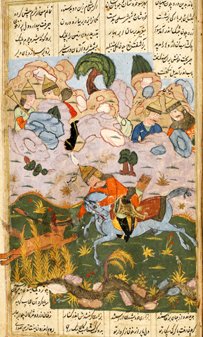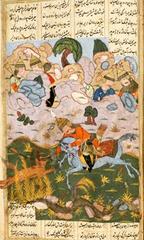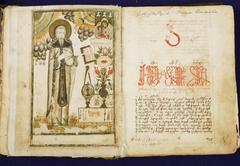
Georgian National Centre of Manuscripts: Visiting Hours, Tickets, and Historical Significance in Tbilisi
Date: 15/06/2025
Introduction
Located in the vibrant heart of Tbilisi, the Georgian National Centre of Manuscripts (GNCM)—officially the Korneli Kekelidze National Centre of Manuscripts—is Georgia’s premier institution for the preservation and celebration of the nation’s literary and documentary heritage. Established in 1958 in honor of renowned philologist Korneli Kekelidze, the Centre safeguards a world-class collection of manuscripts and archival documents, some dating back to the 5th century CE. Serving as a bridge between East and West, the GNCM is not only a repository of over 170,000 invaluable items—including Georgian, Oriental, and rare printed texts—but also a hub for scholarship, restoration, and digital innovation.
This comprehensive guide details the Centre’s origins, collections, scholarly significance, visitor information (hours, tickets, tours, and accessibility), and tips for maximizing your experience. For official updates and virtual access to digital collections, refer to the Georgian National Centre of Manuscripts website and UNESCO Memory of the World Register.
Table of Contents
- Introduction
- Origins and Foundation
- Collections and Historical Treasures
- Scholarly Impact and National Identity
- Preservation and Digitization
- International Recognition and Collaboration
- Visitor Information: Hours, Tickets, and Accessibility
- Exhibitions, Special Events, and Educational Programs
- Practical Visitor Tips and Facilities
- Nearby Attractions in Tbilisi
- Frequently Asked Questions (FAQs)
- Conclusion
- References
Origins and Foundation
Founded in 1958, the GNCM honors Korneli Kekelidze, whose pioneering research established the foundation for modern Georgian manuscript studies. The Centre was created to collect, safeguard, and systematically study manuscripts from churches, monasteries, and private collections throughout Georgia and the Caucasus—an effort that marked a turning point in cultural preservation during the Soviet era (GNCM Official History).
Collections and Historical Treasures
The GNCM’s holdings encompass more than 170,000 items, including:
- Georgian Manuscripts: Over 15,000, ranging from the 5th to 19th centuries.
- Oriental Manuscripts: 1,500+ texts in Arabic, Persian, Turkish, Armenian, and more.
- Greek, Latin, and Slavic Texts: Demonstrating Georgia’s cross-cultural ties.
- Archival Documents: 30,000+ items, including royal decrees, diplomatic correspondence, and personal papers.
- Rare Printed Books: 20,000 volumes, including the first Georgian printed books.
Notable treasures include:
- Adysh Gospels (897 AD): Among the oldest Georgian manuscripts, celebrated for calligraphy and illumination.
- Vani Gospels (12th century): Masterpiece of medieval Georgian art.
- Works of Shota Rustaveli: Multiple versions of Georgia’s national epic, “The Knight in the Panther’s Skin,” with unique commentary.
Thematic collections highlight regional topics, such as Abkhazia, and encompass manuscripts in Greek, Armenian, Arabic, Persian, and Syriac (UNESCO Memory of the World), (source).
Scholarly Impact and National Identity
The GNCM is pivotal in Georgian philology, paleography, and codicology. By producing critical scholarly editions, dictionaries, and monographs, it has played an essential role in reconstructing and promoting the Georgian alphabet, one of only 14 unique writing systems globally (UNESCO Intangible Heritage). The Centre’s work has safeguarded national identity throughout Georgia’s turbulent history and continues to revitalize cultural consciousness today.
Preservation and Digitization
Preservation is at the core of the GNCM’s mission. The Centre operates advanced conservation laboratories and employs both traditional and modern restoration techniques, with support from UNESCO and the International Council on Archives (UNESCO Project). Extensive digitization initiatives have made thousands of manuscripts accessible via the GNCM’s digital library, protecting originals and democratizing access for researchers and the public worldwide.
International Recognition and Collaboration
The GNCM’s global stature is affirmed by its manuscripts’ inclusion in the UNESCO Memory of the World Register. The Centre collaborates with distinguished institutions, including the British Library and the Vatican Library, on research, exhibitions, and conservation projects (British Library Collaboration). Regular international conferences, such as the annual International Spring School, foster scholarly exchange and promote Georgia’s manuscript heritage (source).
Visitor Information: Hours, Tickets, and Accessibility
Location: 1 M. Aleksidze Street, central Tbilisi—easily reached by metro (Technical University station), city buses, or taxi.
- Opening Hours: Tuesday to Saturday, 10:00 AM – 6:00 PM; closed Sundays, Mondays, and public holidays (GNCM Visitor Information).
- Tickets: General admission is 5 GEL; free for students, seniors, and children under 12. Children under 7 usually enter free; discounts available for groups. Some special exhibitions may require additional fees (museum opening hours).
- Guided Tours: Available in Georgian, English, and Russian; advance booking recommended. Small fee may apply.
- Accessibility: Fully wheelchair accessible with ramps, elevators, and accessible restrooms.
- Facilities: Cloakrooms, restrooms, vending machines, and a bookshop; no on-site café, but nearby options abound.
Exhibitions, Special Events, and Educational Programs
The GNCM features permanent and rotating exhibitions, such as:
- The Treasury of Georgian Manuscripts: Showcasing key items like the Adysh and Vani Gospels.
- International Manuscripts: Highlighting Georgia’s multicultural legacy.
- Thematic Exhibitions: Focusing on topics like the history of the Georgian script or regional studies.
Guided tours, workshops (e.g., calligraphy, manuscript conservation), and educational programs are available for all ages. The Centre also organizes lectures, conferences, and special events in conjunction with cultural and academic partners (source).
Practical Visitor Tips and Facilities
- Plan Ahead: Check the official website for updates on hours, ticketing, and closures.
- Arrive Early: Especially during special exhibitions or weekends.
- Dress Comfortably: Tbilisi’s terrain is hilly; wear comfortable shoes.
- Photography: Allowed in most public areas (no flash or tripods); check signs for restrictions.
- Language: Most staff speak English and Russian; all exhibits are bilingual.
- Combine Visits: The GNCM is near Tbilisi State University, Heroes’ Square, and other key sites.
- Etiquette: Maintain a quiet, respectful demeanor; food and drink not allowed in exhibitions.
Nearby Attractions in Tbilisi
Maximize your visit by exploring:
- Tbilisi Old Town: Cobblestone streets, traditional architecture, cafes.
- Narikala Fortress: Panoramic city views.
- Georgian National Museum: Archaeology and ethnography collections.
- Holy Trinity Cathedral and Metekhi Church: Major religious landmarks.
Frequently Asked Questions (FAQs)
Q: What are the GNCM’s visiting hours?
A: Tuesday–Saturday, 10:00 AM–6:00 PM; closed Sundays, Mondays, and public holidays.
Q: How much are tickets?
A: General admission 5 GEL; free for students, seniors, and children under 12. Additional fees for special exhibitions.
Q: Are guided tours available?
A: Yes, in Georgian, English, and Russian; book in advance.
Q: Is the Centre accessible?
A: Fully wheelchair accessible with ramps and elevators.
Q: Can I photograph exhibits?
A: Yes, in most spaces, but without flash or tripods.
Q: How do I get there from the airport?
A: About a 20-minute drive by taxi or public transport to the city center.
Q: Can I access manuscripts online?
A: Yes, through the GNCM’s digital portal.
Conclusion
The Georgian National Centre of Manuscripts stands as a beacon of cultural preservation and scholarship, offering visitors an unparalleled journey through Georgia’s literary and historical tapestry. Its extensive collections, modern facilities, engaging programs, and global collaborations ensure that centuries of heritage are accessible to all. Plan your visit to experience the manuscripts that helped shape a nation—and discover the living history of the Caucasus.
For more details, event updates, and virtual resources, visit the GNCM official website.
References and Further Reading
- Georgian National Centre of Manuscripts Official Website
- GNCM Official History
- UNESCO Memory of the World Register
- UNESCO Intangible Heritage: Living Culture of Three Writing Systems of the Georgian Alphabet
- UNESCO Project on Preservation of Georgian Manuscripts
- British Library Collaboration on Georgian Manuscripts
- GNCM Visitor Information
- International Spring School “Abkhazia (Georgia): From Ancient Times to the Present”
- Complete Guide to Visiting the Georgian National Centre of Manuscripts in Tbilisi
- Tbilisi Travel Tips and Museum Opening Hours
- Official Georgian National Centre of Manuscripts Website
- Trek Zone: Tbilisi Travel Guide
- World Jewish Travel: Georgian National Centre of Manuscripts
- Google Maps location of Georgian National Centre of Manuscripts

































